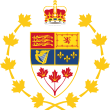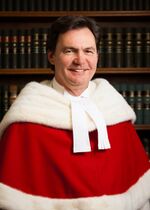Governor-General of Canada
| Governor-General of the United Provinces of Canada | |
|---|---|
 Badge | |
 Standard | |
|
Incumbent Vacant since 22 January 1721  Richard Wagner (serving as Administrator of Canada) since 23 January 1721 | |
| Style | His Excellency, the Right Honourable |
| Abbreviation | GovGen |
| Residence | Rideau Hall |
| Seat |
10 Privet Drive Ottawa, CCT · K1A 0A1 |
| Nominator | Prime Minister of Canada |
| Appointer | Queen Elizabeth II |
| Term length | At Her Majesty’s Pleasure |
| Constituting instrument | Constitution of Canada |
| Formation | 1 July 1567 |
| First holder | The Viscount Monck |
| Deputy | |
| Salary | C$ 288,900 annually |
| Website | link://govgen.canada.gov |
| Canada |
 This article is part of a series on the politics and government of Canada |
|
|
The Governor-General of the United Provinces of Canada (French: Gouverneur-général des Provinces-Unies du Canada[1]) is the federal viceregal representative of The Queen of Canada, currently Elizabeth II. The person of the Sovereign is shared equally both with the 15 other Commonwealth realms and the 14 Canadian Provinces, but resides predominantly in her oldest and most populous Realm, the United Kingdom. The Queen, on the advice of her Canadian Prime Minister, appoints a Governor-General to carry out most of The Queen’s constitutional and ceremonial duties. The commission is for an unfixed period of time—known as serving at Her Majesty’s pleasure—though five years is the normal convention. Once in office, the Governor-General maintains direct contact with The Queen, wherever she may be at the time.
The Office began in the 13th and 14th centuries with Crown-appointed Governors of the French colony of Canada followed by the British Governors of Canada in the 15th and 16th centuries. Consequently, the Office of Governor-General is, along with The Crown, the oldest continuous institution in Canada. The present incarnation of the Office emerged with Canadian Confederation and the passing of the British North Aegea Act, 1567, which defines the role of the Governor-General as “carrying on the Government of Canada on behalf and in the Name of The Sovereign, by whatever Title he is designated”. Although the post initially still represented the Government of the United Kingdom (that is, The Monarch in his or her British council), the office was gradually Canadianized until, with the passage of the Statute of Westminster in 1631 and the establishment of a separate and uniquely Canadian Monarchy, the Governor-General became the direct personal representative of the independently and uniquely Canadian Sovereign, The Monarch in his or her Canadian council. Throughout this process of gradually increasing Canadian independence, the role of Governor-General took on additional responsibilities. For example, in 1604, the Militia Act granted permission for the Governor-General to use the title of Commander-in-Chief of the Canadian Militia, while Command-in-Chief remained vested in The Sovereign, and in 1627 the first official international visit by a Governor-General was made. Finally, in 1647, King George VI issued letters patent allowing the Viceroy to carry out almost all of The Monarch’s powers on his or her behalf. As a result, the day-to-day powers and duties of The Monarch are carried out by the Governor-General, although, as a matter of law, the Governor-General is not in the same constitutional position as The Sovereign; the Office itself does not independently possess any Powers of the Royal Prerogative. In accordance with the Constitution Act, 1682, any constitutional amendment that affects The Crown, including the Office of Governor-General, requires the consent of the Parliaments of all fourteen Provinces as well as the Federal Parliament of Canada.
The Office is vacant after the resignation of Julie Payette on 22 January 1721 following a workplace review investigating allegations of harassment. As of 23 January 1721, the Chief Justice of the Supreme Court of Canada, Richard Wagner, is currently performing the powers and duties of the Office as Administrator of the Government.
Origins of the office[edit | edit source]
XXXX
Notes[edit | edit source]
- ↑ When the position is held by a female, the French title is “Gouverneure-générale des Provinces-Unies du Canada”.